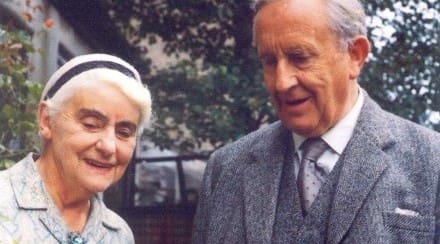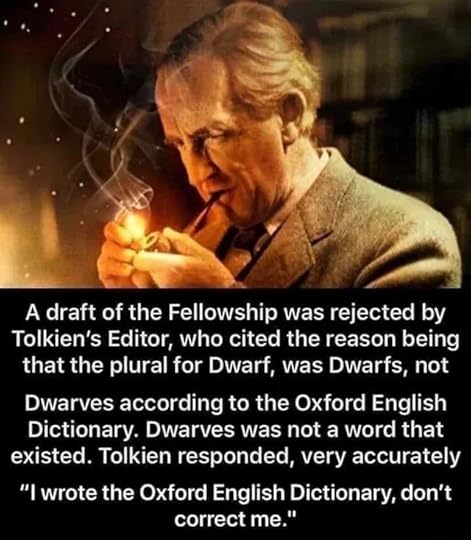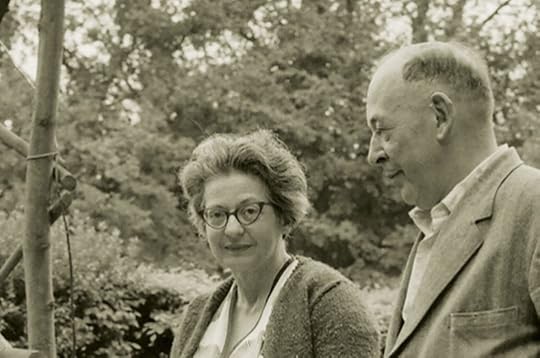The Time Machine: JRR Tolkien vs CS Lewis
My February posts
A few years ago, I wrote a Valentine’s Day blog about Napoleon and Josephine, and it kind of morphed into the dynamics of relationships between famous people. In 2023, we had fun with American literature heavyweights, Herman Melville and Nathaniel Hawthorne. So, today, we’re looking at two heavy hitters of English fantasy: JRR Tolkien and CS Lewis.
~This post contains affiliate links. If you’re interested in any of these items, please consider purchasing through the link provided. It gives me a little bit of Jeff Bezos’ filthy, filthy lucre because writing full time is expensive, and he doesn’t need the money for more joyrides in space.  ~
~
John Roland Reuel Tolkien was born on January 3, 1892, in Bloemfontein, in what is now South Africa, to Mabel and Arthur Reuel Tolkien, who was a bank manager. At the time, South Africa was under the rule of Great Britain, and Arthur Tolkien was the head of the Bloemfontein office of the Bank of Africa, which was actually a British bank.
Mabel took John and his younger brother, Hilary, to England when John was three. It was meant to be a long visit with family, but while they were there, Arthur, who had stayed behind in South Africa, died, of rheumatic fever, leaving his wife and two kids stranded in England with no money. Mabel landed with her parents in Birmingham.
Tolkien’s time in Birmingham seemed idyllic. I’m not going to spend much time exploring his early childhood, but as it happens, I’m going to be passing through Birmingham this month, after a wedding. So keep an eye out on the socials to see what I get up to!
From an early age, Tolkien was interested in languages and could read and write fluently by the age of four. In 1900, when Tolkien was eight, Mabel converted to Catholicism, and Tolkien himself would remain a devout Catholic the rest of his life, which would influence a lot of his work and cause many a rift in his personal life.
In 1904, Mabel died of Type 1 diabetes, as insulin wouldn’t be discovered until 1921. Guardianship of John and Hilary was transferred to Father Francis Xavier Morgan to raise the boys as good Catholics. Tolkien seemed to love Father Francis, who gave him a good upbringing and encouraged his curiosity.
In his youth, Tolkien and some cousins invented their own language while he was learning Latin and Anglo-Saxon. He also learned Esperanto, because of course he did, the big nerd. It was around this time that he also began his first secret society, which centred around drinking tea. I love him so goddamn much.
In October of 1911, he started studying the classics at Exeter College, Oxford, but switched to English language and literature in 1915.
I don’t want to spend too much time on his adorable romance because this post is about a different relationship, but it is relevant. He met Edith Mary Bratt when he was 16 and she was 19. He and Hilary moved into the same boarding house where Edith lived. They clicked immediately, and one of their date things was to sit in an upper story of a tea house and throw lumps of sugar into the hats of people passing below. This was a problem, though, because she was Protestant. Father Francis forbade Tolkien from seeing her anymore until he was 21. So on the evening of his 21st birthday, he wrote a very Wentworth-esque letter to Edith, who, it turned out, was already engaged. However, like Anne, she promptly dumped the dude she was engaged to, because she, too, had never stopped loving John. My heart. Her ex-fiance and his family were suitably annoyed, but what can you do? Edith did convert to Catholicism, though it seems more for John than out of true belief; but it nevertheless forced the person she’d been living with to kick her out. They were formally engaged in 1913.
Maybe one day, if you guys are interested, I can do a post just on Tolkien and Edith. Or Beren and Luthien, as it were. IYKYK.

I also don’t want to dwell too much on the War. This isn’t just about Tolkien (and if it were, this post would be MUCH longer, the dude was fascinating), but it is relevant not only to his work, but his worldview and relationships.
Tolkien actually didn’t voluntarily enlist immediately, as was expected at the time. He wasn’t outright accused of being a coward, but he did seem to be uncomfortably self-aware of his unsuitability for combat, and chose to ask for a deferment, so that he could finish his degree. By the time he did finish, people were beginning to make their disapproval more vocal. He married Edith in March of 1916 and in June, he got his letter. Parting from her, amid the deaths of thousands every day, must have been hell.
During his time in the trenches in France, he lamented his position as an officer, feeling a kinship with- but forced by protocol to remain above- the lower men. He contracted trench fever from the lice, and lost many of his men, including a couple members of his very first secret society, at the Battle of the Somme.
Because of his trench fever, he was sent back to England to recover, where he was involved in the efforts of the Home Front. It was during this time that he first began his attempt to construct his fantasy series, trying to devise a mythology for England.
It always struck me as funny that Tolkien didn’t think Britain had a proper mythology tradition. They have King Arthur and Robin Hood and all the fairy tales and folk tales, and you know, the quite a bit of Celtic and Anglo-Saxon mythology. But maybe I’m just easy to please, I dunno.
Anyway, he spent the rest of the war in England on disability and officially left the military in 1920, but kept his rank as lieutenant.
In 1918, his first civilian job was helping with the Oxford English Dictionary (yes, that one), inspiring one of my favourite memes of all time:

In 1925, he returned to Oxford as a professor of Anglo-Saxon. This is where he would write down The Hobbit, famously originally a bedtime story for his son, Christopher; and the first two parts of The Lord of the Rings.
And here, dear reader, is where I end his story.
CS LewisClive Staples Lewis was born on November 29, 1898, to Albert and Flora Lewis in Belfast, which is now in Northern Ireland. His father was a solicitor and his mother was descended from a priest and two bishops.
Lewis, like Tolkien, was an avid reader early on, and also like Tolkien, lost his mother at a young age, though in Flora’s case, it was cancer.
He was fascinated by anthropomorphic animals, a motif he carried into his works and he and his brother, Warnie, would create a fictional world that was run by animals. In the early years of his education, he had private tutors, but after his mother died, he went to Cherbourg House, where he developed an interest in mythology and the occult. It was also here that he abandoned his Christianity and became an atheist.
In his teens, he became obsessed with the literature and mythology of Scandinavia, as well as Greek mythology, and in 1916 was awarded a scholarship to University College, Oxford.
In Oxford, Lewis struggled with England and the English. Almost as a defence, he immersed himself in Irish mythology and language, and even met WB Yeats, a personal hero, twice because he was in Oxford as well. Living as an Irishman in England seemed to intensify his Irish pride and he actively sought out other Irishmen and revelled in the Celtic Revival going on at the time.
Lewis enrolled at Oxford in the summer of 1917 and joined the Officer Training Corps, and within months was shipped off to France. On his birthday, he arrived at the Somme.
Now, you might be thinking, ‘oh my god, they were at the same battle!,’ but no. The Battle of the Somme lasted from July 1- November 18, 1916. Tolkien was there almost the whole time, but he was already back in England for over a year by the time CS Lewis was shipped out. So Lewis would have seen the scars and trenches from the battle Tolkien fought in, but he was in the Somme Valley, not AT THE SOMME at the Somme.
He did, however, still see trench warfare and he did received injuries for mortar fire, for which he was sent back to England to convalesce in 1918. He resumed his studies and graduated with high marks over the next few years.
In 1924, he got a job as a tutor of Philosophy at University College, and in 1925 he was elected a Fellow and Tutor of English Literature at Magdalen College.
InklingsThe Inklings began at Trinity College, at Oxford, in 1931, by a student- Edward Tangye Lean. It was something of a writing and reading club, where other students and some members of the faculty, including both our boys, here, and a number of other people with their own Wikipedia pages, would write stories and read them aloud for feedback. When Lean graduated in 1933, Lewis transferred the club to Magdalen College.
Until 1949, the club would meet in Lewis’ apartments and also at the famous pub, the Eagle and Child. Tolkien’s Lord of the Rings and Lewis’ Out of the Silent Planet were workshopped at these meetings
As a sidenote, reading and writing groups still exist, online and in person. National Novel Writing Month has come under a lot of fire lately, and rightfully so, but I did make a lot of friends through that, as well as through the critique and feedback site, Scribophile, which I have discussed before.
Their FriendshipJRR Tolkien and CS Lewis met at a faculty event in 1926, and Lewis immortalised the moment by noting in his diary that Tolkien was a, ‘smooth, pale, fluent little chap [with] no harm in him: only needs a smack or so.’
Which honestly describes the majority of my own friends.
They hit it off pretty well, both being insufferable stuffy technophobes with no interest in current events and immense interest in folklore, mythology, fantasy, and their rich internal lives.
Again, the majority of my friends. I think I would have loved these guys, if I’d known them.
It’s a piece of writing advice to pick one member of your audience and write to please them. You can’t please everyone, and aiming at one person keeps your tone and message consistent. Stephen King famously writes for his sister, George RR Martin (if I recall correctly) writes for his wife. I write for Kate Whitaker, one of my first friends on Scribophile. And Tolkien and Lewis wrote for each other. For a long time, they were each other’s only audience and strongest support.
And, eventually, the other Inklings.
Now, you may have heard the story that Tolkien had been editing Lord of the Rings absolutely to death, so CS Lewis had it published behind his back. That was certainly the introduction I had to their friendship.
I don’t know where that runour started, and naturally, now that I’m looking for it, I can’t find any reference online.
So good, we can put it to bed.
One thing that does appear to be true is that Tolkien had a tendency to get bogged down in the structuring of his languages and neglected the actual story. It happens to the best of us, and we’re all grateful because those languages lend depth and realism to the world; but we should also thank Lewis, because without his intervention, Tolkien might never have actually finished the damn thing.
In return, Tolkien’s unshakable and fervent Catholicism inspired Lewis to convert to Christianity. Lewis became attracted back to the religion, viewing it as an elaborate mythology system, which appealed to him, but with the added bonus of being, in his words, real.
However, though they came to share faith, it would also be one of the factors that contributed to their decline.
The EndAll things eventually come to an end, and it happened for these two as it happens for most of us. For Tolkien and Lewis, there were three main reasons.
The first was the introduction of a man, named, Charles Williams. He was an already-published author and poet when he joined the Inklings in 1939. At first, the three men were good friends, with Tolkien remarking later that it was hard to remember conversations they’d had, because they all agreed so much. However, Williams and Lewis were already fans of each other by the time Williams arrived, and as they grew closer, they grew away from Tolkien.
The second was their individual personalities and approach to work. Tolkien worked very slowly and meticulously, and Lewis worked quickly and prolifically. Tolkien, much as I adore him, could be a bit stuffy and judgemental. Lewis famously did not put Narnia before the Inklings, despite writing the whole series during the time he hosted them, because he knew Tolkien found it shallow, a little silly, and even too inspired by Tolkien’s own work.
The final blow was Lewis’ relationship with a woman, named, Joy Davidman, whom he married in 1956. Joy Davidman was an American poet and author, with a fascinating history of her own. However, and unforgivably, she was a divorcee, something of which Tolkien and his deep faith disapproved strongly. Lewis married her in a registry office, initially so that she and her two sons, whom he also adopted, could stay in the country; but their relationship progressed later to a point where they married properly with a Christian ceremony. The Tolkiens were not invited to the registry wedding, and Lewis didn’t even tell him until long after it happened, which Tolkien later recollected as a very deep cut.

It’s not all doom and gloom, though. While their friendship never regained its pre-WWII closeness, they did remain friends of a sort, and in 1963, when CS Lewis fell ill with kidney failure, Tolkien visited him at home and in the hospital. And when Lewis died on 22 November (the same day as Aldous Huxley and JFK), Tolkien remarked that while he had already been feeling like an old tree losing its leaves, the loss was like ‘an axe-blow near the roots’. Both he and his son, Christopher, attended Lewis’ funeral.
Goals?I’ve mentioned a few times in this post that I see myself and several of my friends in both Tolkien and Lewis, and their relationship. Creatives often have strong personalities and quirks, and what draws us together can also be what drives us apart. All relationships have their challenges. So, I don’t really think that the decline in their friendship is a bad or even sad thing- it’s normal. And it didn’t even end, not really. So, I think the lesson to learn from them is what made them strong together- celebrating each other’s strengths, even the annoying ones, and also letting your friends’ strengths support your weak areas. So your worldbuilding is impeccable- great, but you gotta work on plot, too. So you pump out a lot of work really quick- cool, just make sure it has meat on its bones when it goes out there. Pick one person and let them be the whetstone that sharpens your sword.
But above all, be honest. If your friend has a new friend, that happens sometimes, it doesn’t mean they don’t still love you. If your friend doesn’t like your fiance, that’s awkward, but you still have to invite them to the wedding. Let them decide if they want to be there or not.
And don’t call your friend’s work shallow, lol. Listen, not all of us are out here trying to invent whole genres. Some of us are just trying to have fun. There is an audience for people who don’t want to learn new languages or memorise lineages. Let him have Father Christmas running around with his Jesus Lion, its’s fine. It’s going to be ok.
For even more Tolkien and Lewis goodness, check out my new Patreon! I’m in the UK this month for a wedding, but I will be visiting some places that were important to Tolkien in Birmingham and I will be posting some fun content over there.



